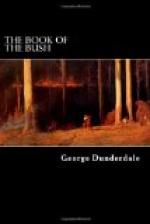Next day the bishop went further up the river to Wherinaki, where Laming, a pakeha Maori, resided. Laming was an Irish-Protestant who had great influence with his tribe, which was numerous and warlike. He was admired by the natives for his strength and courage. He was six feet three inches in height, as nimble and spry as a cat, and as long-winded as a coyote. His father-in-law was a famous warrior named Lizard Skin. His religion was that of the Church of England, and he persuaded his tribe to profess it. He told them that the Protestant God was stronger than the Catholic God worshipped by his fellow countryman, Poynton. In after years, when his converts made cartridges of their Bibles and rejected Christianity, he was forced to confess that their religion was of this world only. They prayed that they might be brave in battle, and that their enemies might be filled with fear.
Laming’s Christian zeal did not induce him to forget the duties of hospitality. He received the bishop as a friend, and the Europeans round Tatura and other places came regularly to Mass. During the first six years of the mission, twenty thousand Maoris either had been baptised or were being prepared for baptism.
Previous to the year 1828 some flax had been brought to Sydney from New Zealand, and manufactured into every species of cordage except cables, and it was found to be stronger than Baltic hemp. On account of the ferocious character of the Maoris, the Sydney Government sent several vessels to open communication with the tribes before permitting private individuals to embark in the trade. The ferocity attributed to the natives was not so much a part of their personal character as the result of their habits and beliefs. They were remarkable for great energy of mind and body, foresight, and self-denial. Their average height was about five feet six inches, but men from six feet to six feet six inches were not uncommon. Their point of honour was revenge, and a man who remained quiet while the manes of his friend or relation were unappeased by the blood of the enemy, would be dishonoured among his tribe.
The Maoris were in reality loath to fight, and war was never begun until after long talk. Their object was to exterminate or enslave their enemies, and they ate the slain.
Before commencing hostilities, the warriors endeavoured to put fear into the hearts of their opponents by enumerating the names of the fathers, uncles, or brothers of those in the hostile tribe whom they had slain and eaten in former battles. When a fight was progressing the women looked on from the rear. They were naked to the waist, and wore skirts of matting made from flax. As soon as a head was cut off they ran forward, and brought it away, leaving the body on the ground. If many were slain it was sometimes difficult to discover to what body each head had belonged, whether it was that of a friend or a foe, and it was lawful to bake the bodies of enemies only.




